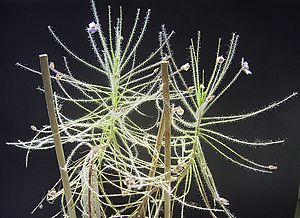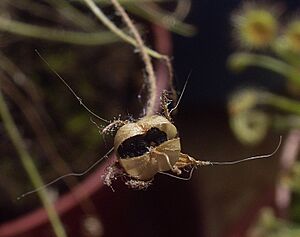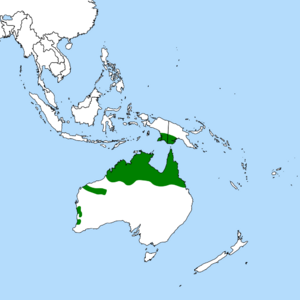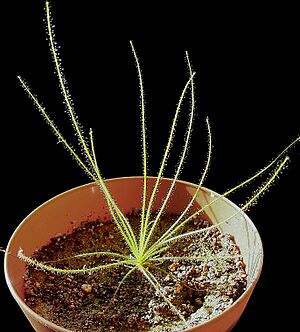Byblis (plant) facts for kids
Quick facts for kids Byblis |
|
|---|---|
 |
|
| Byblis liniflora | |
| Scientific classification |
|
| Kingdom: | Plantae |
| Clade: | Tracheophytes |
| Clade: | Angiosperms |
| Clade: | Eudicots |
| Clade: | Asterids |
| Order: | Lamiales |
| Family: | Byblidaceae Domin |
| Genus: | Byblis Salisb. |
Byblis (pronounced BIB-liss) is a small group of carnivorous plants. They are sometimes called the rainbow plants because their sticky leaves sparkle like a rainbow in bright sunshine. These unique plants are found only in western Australia. Byblis is the only genus in its plant family, called Byblidaceae. The first Byblis species was described by an English botanist named Richard Anthony Salisbury in 1808. Today, we know of eight different species.
Byblis plants look a lot like other carnivorous plants such as Drosera (sundews) and Drosophyllum. However, you can tell them apart by their special flowers. Byblis flowers have five curved parts called stamens that are all on one side. Even though they look similar, Byblis plants are not closely related to sundews. Byblis belongs to the plant order Lamiales, while sundews are in the Caryophyllales order.
| Top - 0-9 A B C D E F G H I J K L M N O P Q R S T U V W X Y Z |
Plant Features: What Makes Them Special?
All Byblis species grow upright and have a weak root system. Scientists divide the genus into two main groups: the B. liniflora group and the B. gigantea group.
Leaves: Sticky Traps for Insects
The leaves of all Byblis species are long and thin, like a rounded stick, and they get narrower at the end. The surface of the leaves is covered with tiny hairs that produce a sticky, gooey substance. This goo acts like super glue, attracting small insects. When an insect touches the sticky goo, it gets stuck. If the insect isn't strong enough to escape, it will die from exhaustion or suffocate as the goo covers it.
Unlike sundews, Byblis plants cannot move their sticky hairs or their leaves to help catch or digest prey. Because of this, they are called "passive flypaper traps." Other plants that use this method include Pinguicula and Drosophyllum.
Besides the sticky hairs, Byblis leaves also have tiny, flat glands. These glands are thought to release the special liquids that digest the insects. There are many more of these digestive glands than the sticky ones.
Flowers: Pretty Pollinators
Byblis flowers grow one by one at the end of long, leaf-like stems that come out from the main plant. The flowers usually have five petals and are purple or light violet. However, B. gigantea and B. filifolia can sometimes have white flowers.
Most Byblis species need pollen from another plant to make seeds, except for B. liniflora, which can pollinate itself. The flowers of B. gigantea and B. lamellata have a special trick: they only release their pollen when a pollinator, like a bee, lands on them and vibrates its wings at a certain frequency. This helps make sure the pollen is spread to other plants. Byblis flowers start blooming in early spring and continue until late summer.
Fruit and Seeds: Spreading Life
After a flower is pollinated, it grows into an egg-shaped seed capsule with two parts. When the capsule dries out, it cracks open and drops the black seeds onto the ground. This is called gravity dispersal.
The seeds are usually round and often have web-like patterns on their surface. However, the seeds of B. lamellata have strong ridges. Many Byblis species need bush fires to happen after a dry season for their seeds to sprout. Special chemicals in the smoke from these fires help trigger the seeds to grow.
Where Do Rainbow Plants Live?
All Byblis species are native to Australia. B. gigantea and B. lamellata are found only in the Perth area of southwest Australia. The species in the B. liniflora group are found only in northern Australia. The only exception is B. liniflora itself, which also grows in southern Indonesia and Papua New Guinea.
Like many carnivorous plants, Byblis species usually grow in wet, marshy areas. They prefer sandy soil that gets wet during certain seasons, with partial or full sunlight. They can handle temperatures between about 5 and 40 degrees Celsius (40-105 degrees Fahrenheit).
Protecting Rainbow Plants
Since Byblis plants are native to Australia, all species are protected there. Until 2000, they also had international protection under a treaty called CITES. However, after Australia joined the CITES agreement, Byblis was removed from the international list. This means that outside of Australia, there are no rules about trading these plants.
Because Byblis plants are quite sensitive, only a small group of carnivorous plant fans are interested in growing them. Most of the plants sold today are grown by people, not collected from the wild. The annual species, B. filifolia and B. liniflora, are the most common ones to grow. Most other species need to be grown from seeds, which are often collected from the wild.
The two species from Western Australia, B. gigantea and B. lamellata, are in danger because their habitats are being destroyed. This is happening as cities like Perth grow and expand. Draining wet areas to create farmland is especially harmful. B. gigantea is on the Red List of Threatened Species and is considered critically endangered.
Are They Really Carnivorous? The Mystery Solved
For a while, people wondered if Byblis plants were truly carnivorous. In their natural homes, scientists noticed that certain bugs from the genus Setocoris lived on the Byblis plants. These bugs ate the insects that the Byblis plants caught.
Because of this, some thought that Byblis plants didn't actually digest their prey themselves. Instead, they might rely on these bugs to do the digesting. Then, the Byblis plants would absorb nutrients from the bugs' waste, either through their leaves or from the soil. Some even suggested that a special fungus helped break down the nutrients.
However, in 2005, scientists proved that B. filifolia directly digests insects using special liquids released by its flat glands. Soon after, similar results were found for B. liniflora. These discoveries clearly show that Byblis plants are indeed true carnivorous plants!
Different Types of Rainbow Plants
Scientists have placed Byblis in the plant order Lamiales. While its exact spot within this order is still being studied, it is closely related to plants like Martyniaceae and Lentibulariaceae.
For some time, another plant genus called Roridula was thought to be in the same family as Byblis. But now, Roridula has its own family, called Roridulaceae.
Traditionally, only two Byblis species were recognized: B. gigantea and B. liniflora. But in the 1980s, more species were discovered, thanks to the work of Australian botanist Allen Lowrie. Today, eight species are officially recognized:
- Byblis aquatica: An annual plant (lives for one year) that can grow up to 45 cm (18 in) tall. It often grows in watery places.
- Byblis filifolia: An annual plant that can reach 60 cm (24 in) tall. Its pollen-producing parts (anthers) are longer than their stalks (filaments).
- Byblis gigantea: A perennial plant (lives for many years) that can grow up to 70 cm (28 in) tall. Its seeds have a honeycomb pattern.
- Byblis guehoi
- Byblis lamellata: A perennial plant that can grow up to 45 cm (18 in) tall. It has seeds with deep ridges.
- Byblis liniflora: An annual plant that grows up to 15 cm (5.9 in) tall. Its anthers are shorter than their filaments.
- Byblis pilbarana
- Byblis rorida: An annual plant that grows up to 30 cm (12 in) tall. It is covered in many sticky glands.
The Byblis liniflora Group
This group includes four species: B. liniflora, B. rorida, B. filifolia, and B. aquatica. These are annual plants, meaning they grow from a seedling, flower, make seeds, and then die within a few months when the dry season starts. They usually grow between 15–50 cm (5.9–19.7 in) tall, with leaves up to 4–15 cm (1.6–5.9 in) long.
The Byblis gigantea Group
The other two species, B. lamellata and B. gigantea, form the B. gigantea group. These are perennial plants, meaning they live for many years. They are found only in Southwest Australia and can grow between 45–70 cm (18–28 in) tall. Unlike the annual species, these plants survive the dry season by dying back to an underground stem called a rhizome. They then grow back from this rhizome when the wet season returns. Their leaves can grow up to 20 cm (7.9 in) long.
What's in a Name?
The scientific name "Byblis" comes from a goddess in Greek mythology. The ancient Roman poet Ovid wrote about her in his book Metamorphoses. Byblis, who was the niece of the god Apollo, fell deeply in love with her twin brother, Caunus. When he rejected her, she cried so much that her tears turned into an endless stream. The sticky droplets on the leaves of the Byblis plant are said to look like those tears.
The English name "rainbow plants" also comes from these sticky droplets. When the light hits them just right, they sparkle with all the colors of the rainbow!





